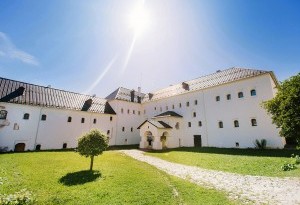The chambers of the merchant Pogankin, Pskov

The Pskov State United Historical-Architectural and Art Museum-Reserve, in fact - the main museum of Pskov, was founded in 1876. From 1900 to the present day it is located in the chambers of the merchant Pogankin - a stone residential building of the second half of the XVII century, which belonged to the Pskov merchant Sergei Ivanovich Pogankin. The building, by the way, has never been rebuilt.
In the museum, as academician Grabar used to say, “unexpected and joyful discoveries await us,” namely, a magnificent collection of ancient icons, medieval silver, rare weapons and a very good art gallery.
If the ancient Pskov architectural school at the suggestion of Le Corbusier can be called “medieval constructivism,” then its modern icon painting can be called “Old Russian expressionism”: bright, glowing inside colors, tense dynamics of compositions and poses seeking the views of the characters. This art has arisen and flourished in a small but very rich medieval Pskov - militant, forever warring with its neighbors: the Order, Lithuania, Novgorod. The wealth of Pskov was based on trade, one of the main articles of which was the re-export of non-ferrous metals - but not from east to west, as in the recent nineties, but from west to east: at that time in Russia nothing except bread was extracted from the earth, and medieval Russia rulers, even for minting their own coins, had to import silver mined in Czech, English and Swedish mines.
Ancient Pskov was sitting on this super-profitable transit, its magnificent art presented in the museum collection testifies to this magnificent conjuncture: huge massive church bowls, panagias, rizas for icons - weighing several kilograms, gilded, decorated with rare pearls and precious stones, covered with the most sophisticated skan', basma and carving.
The treasures needed protection: in the hall next to the silver in a transparent ark there are two swords that were once kept in the sacristy of the main Pskov cathedral: these are the sacred weapons of the holy Pskov princes Dovmont and Vsevolod. During the centuries of the existence of the free Pskov with the enthronement of the next ruler, the Pskovs did not crown it, but they girded it with one of these swords. These are the rarest historical artifacts and magnificent samples of medieval weapons.
On the territory of Pskov, the Prikaznaya Chamber (administrative building of the 17th century) and the Transfiguration Cathedral of the Mirozhsky Monastery (12th century) belong to the museum-reserve. In the region there are museums-estates of Rimsky-Korsakov, Mussorgsky, Kovalevskaya, memorial apartments of Academician Vinogradov, architect Spegalsky, temples with frescoes of the 14th-15th centuries, fortifications.
HISTORY
The chambers of the merchant Pogankin were built in the 70s-80s of the 17th century by order of the well-known and richest Pskov merchant Sergei Ivanovich Pogankin, who was in charge of the money court and customs in Pskov, was a tavern head and conducted extensive trade.
The whole complex of U-shaped stone buildings was erected simultaneously. The three-story building was intended for the owner’s family, the two-story building was for the family of his adult son. In the one-story building housed the kitchen.
In 1711, the last representative of the family, Grigori Yuryevich Pogankin, died, and according to his will, the chambers and all his property were transferred to the church. In 1747 the building was purchased by the treasury. In the wards, a food warehouse was arranged first, later a powder warehouse. In 1900, the chambers of the merchant Pogankin were transferred to the Pskov Archeological Society, and two years later, after the first restoration, the Historical Museum was opened in them.
Outside the chambers of the merchant Pogankin look extremely simple, there are no decorations whatsoever. The front surfaces of their goals. The building resembles a fortress, even the outside feels the thickness of the walls, and the windows look like loopholes. Previously, there were bars on the windows, and all 105 windows were shuttered. All buildings erected from natural material - a white limestone slab. From the cellars of the chambers they took out two underground passages, one led to the patrimonial church of the owner of the chambers, where he was later buried.
The preserved stone part of the chambers has reached our time with very minor changes - only two porches of the chambers that overlook the courtyard and the upper extremities of the stairs that connected the stone rooms with wooden mansions that rose above the building along the entire length have been lost.
Today in the chambers of the merchant Pogankin are exhibits of the Pskov Historical, Artistic and Architectural Museum-Reserve. The rich collections of the museum chambers were ravaged and looted by the fascists during the Great Patriotic War. Many exhibits are lost forever. The exposition of the historical department of the museum tells about the life of the region from the Neolithic period to the present day. Among the exhibits there are a lot of objects of production, life and culture of Pskovs of the 11th-12th centuries, products of local masters of leather, pottery, and foundry.
Legends
There are many legends among the people about the merchant Pogankin - one is more terrible than the other. Not a single good word.
According to one legend, he was once a vagabond, but found a treasure and, having become acquainted with the "demonic money", became a fierce man. According to the second, he was the chieftain of the robbers, who shed a lot of human blood and on the loot built chambers called “The Pogankins”. According to the third, he was nicknamed by Ivan the Terrible - for the arrogance and dishonestly acquired wealth.
Join our tours and take a look at this amazing attraction:
Excursions - www.uvisitrussia.com/day-tours/
Tours - www.uvisitrussia.com/tours/



